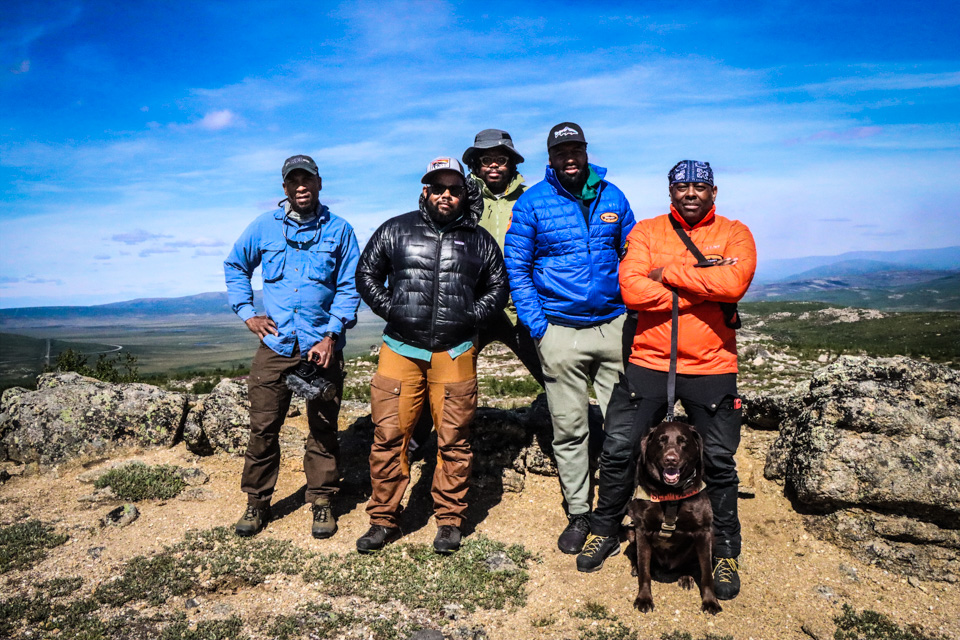People of color make up more than 40 percent of the U.S. population, but are still vastly underrepresented in our country’s national parks, accounting for just over 20 percent of visitors in a typical year.
That racial divide is one that National Geographic contributor James Edward Mills, author of The Adventure Gap, is working hard to bridge, both through his outdoors writing and his role in Blackwaters: Brotherhood in the Wild, the new documentary coming to Minneapolis on May 16 as part of the Minneapolis Parks Foundation’s Next Generation of Parks series.
Mills is one of five Black fly-fishermen in the film, gathered together for a trip of a lifetime to the Gates of the Arctic National Park, and for a revealing conversation about how to make wild places where everyone belongs. The whole team will be on hand after the screening at Mia for a panel discussion led by Melanin in Motion’s Anthony Taylor.
This film features five Black outdoor leaders who all come together for this trip. Where did the idea start?
All of us had been doing work to get underrepresented segments of the population into the outdoors for years, and in 2021, we were all attending a conference in North Carolina. Independently, we all brought our fishing gear, and as we’re on the river, it became clear that this was the first time that many of us had ever fished with that many Black men at the same time. As we got into the conversation, [Blackwaters director] Chad Brown suggested we should go to the Arctic together and share the experience on film. So that’s how the five of us came together, along with a fabulous cameraman, Dudley Edmondson, who’s from Duluth, Minnesota.
Make your pitch: Why should people see Blackwaters?
This is a film unlike anything that I’ve ever seen. I personally have never seen this many Black fly-fishermen on one screen in my entire life! But it’s also a very candid look into the lives of Black men, not only relative to their lives in the outdoors, but also relative to their lives as men. You know, we talk about many of the issues and challenges that Black men in the 21st century face simply because of our identity. More than anything else, what we want is for people to see themselves through us, and hopefully, see themselves in the outdoors.
As a writer and podcaster, you often shine the light on people of color who broke barriers in the outdoors in a series you call “Unhidden.” Tell us more about that.
That’s a project that I’m working on in partnership with National Geographic in cooperation with the National Park Service, to tell the untold stories of Black American history that are interpreted by the national parks. It is a sweeping narrative literally starting from the island of St. Croix in 1492, with the landing of Columbus, all the way to the first Black American to summit Denali in 1964. The next project that I’m working on in the field will be a retracing of a portion of the Lewis and Clark expedition along the Missouri River in Montana to tell the story through the eyes of York, [Clark’s enslaved servant,] and the first Black American to cross the continent.
Why is the Civil Rights Act important to understanding how people of color experience the parks and other natural places?
People of color have been engaged in outdoor recreation quite literally since the very beginning. But until the passage of the Civil Rights Act of 1964, you literally had national parks, national historic sites, and public land that was segregated by race. The broader national park system wasn’t desegregated until 1950, but being able to visit the parks, with the protections of that law, really does not happen until the late 60s. I’m 57 and ours is the first generation in which there are legal protections that enable us as citizens to frequent these places without fear–or well, without legal fear of prohibition. That’s why Blackwaters is the first fly-fishing film that I’m aware of with an exclusively Black cast, behind the camera and in post-production. It’s only been in the last decade or so that we’re starting to see people of color exercising their own leadership, their own entrepreneurship, their own cultural and social influence to say we’re having these transformative outdoor experiences ourselves, and with each other. We’re making it happen.
What lessons did you take out of traveling with these men and making this film?
When it comes to outdoor adventures, I’m a meticulous planner. To me, the only thing that should ever be unpredictable– and even then to only a modest degree–is the weather. But I think the biggest thing that I’ve learned through this entire process is that it’s important not to take important work too seriously, especially when you’re in the business of enjoying yourself in the outdoors. The guys that were on this trip were even more capable than I thought, which is always a good thing to discover, and I’m thrilled that we made it safely back home to our friends and families, and that we have the ability to share this very positive experience with one another, and with people who come and see the film.
Featured image credit James Edward Mills.

